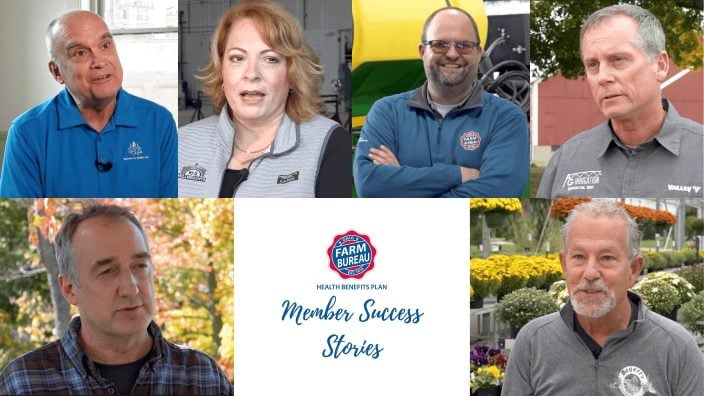Farmer’s Guide to Trucking Regulations available to Ohio Farm Bureau members
The guide includes a farm driver checklist, overview of state and federal regulations and exemptions, CDL qualifications and more.
Read More
Summer is finally here. School is out, pools are open, picnics are abundant and what better way to celebrate all of this than with a dairy delicious treat.
Did you know that June is National Dairy Month?
June 1 was World Milk Day.
Dairy farmers work hard day in and day out to provide a nutritious, quality product. Many people tend to think of the typically black-and-white cow, and think of a cow producing milk and it being readily available on grocery store shelves. In reality, dairy farming is quite complex.
Foremost, did you know that there are seven breeds of dairy cattle?
The seven are: Ayrshire, Brown Swiss, Guernsey, Holstein, Jersey, Milking Shorthorn, and Red and White Holstein. Holsteins are your typical black-and-white cow and are the most common of the breeds.
Ayrshires tend to be a burnt-orange color with white markings as well. Brown Swiss typically are gray to tan in color and are known for their strength. Guernseys are fawn and white, and their milk tends to be rich in beta carotene, and often A2, meaning that it only has one type of protein, A2 beta-casein. Jerseys are brown and often noticed for their small stature and high butterfat in their milk. Milking Shorthorns are commonly a very deep red color, or even roan, and tend to have a more rounded composition. Finally, the Red and White Holstein possesses many of the same characteristics as the regular Holstein, just red and white in color.
Dairy cattle are milked at least twice a day, some farms even milk three times a day. There are different types of barns that dairy cattle can be housed and milked in. Some types of housing for dairy cattle can include free stall barns, tie stall barns, and pack barns. All have their own advantages.
In addition, cows can be milked in a tie stall, step-up parlor, parallel parlor, herringbone parlor, rotary parlor or robot. No matter which form that the farmer chooses to house and milk their cows, the cows ultimately have access to free choice feed and water, and fresh, clean bedding.
Dairy farming requires a lot of dedication and passion. The cows need fed and milked 365 days out of the year. It doesn’t matter if its 100 degrees, or zero degrees, or if it’s Christmas, or just an average weekend. Farmers put in long hours and work vigorously to make sure that their herd is receiving top notch care in order to yield a nutrient dense product for the public to consume. Many people do not think of where their food comes from. They go to the grocery store and get it off of the shelf, and don’t think of the trail that it took to get to the shelf.
In summary, the average dairy cow has her first calf when she is 2 years old. At this point, the cow will start producing milk. Milk from dairy cows is cooled and stored on farm in a bulk tank until the milk truck comes to pick it up every day, or every other day. It then travels to a processing facility where it goes through several quality tests, it is then pasteurized, homogenized, bottled and then distributed to grocery stores. All of this happens in a rather quick, yet careful manner. All milk that is sold is antibiotic free and goes through many tests to assure this. Farmers are not going to risk selling an unsafe product with medicinal residue. Any milk that tests positive for residue is discarded at the farmer’s expense.
With that, I hope that all of the information above gives you a brief look into the daily happenings on a dairy farm. There are so many details and systems that need to go together for things to function properly on demand, daily. Farmers utmost goal is to produce a safe, and nutrient-dense product for the public. If you have questions on where your food comes from, or how it is made, do not be afraid to reach out and ask. We are more than willing to help you understand the practices. With almost half of the month still left, I urge you to go try a new ice cream shop, buy a new type of cheese to have on your burger, or try a different brand or flavor of milk. Dairy, natures nearly most perfect food deserves the celebration all month long.
Submitted by Julie Holler, a member of the Trumbull County Farm Bureau board of trustees.
OFBF Mission: Working together for Ohio farmers to advance agriculture and strengthen our communities.


The guide includes a farm driver checklist, overview of state and federal regulations and exemptions, CDL qualifications and more.
Read More


ODA will enroll 500,000 acres into the program for a two-week sign-up period, beginning April 22, 2024, through May 6, 2024. Contact local SWCD offices to apply.
Read More

Katie Share of Columbus has been named ExploreAg and Youth Development Specialist for Ohio Farm Bureau.
Read More

Mary Klopfenstein of Delphos has been named Young Ag Professional and Ag Literacy Program Specialist for Ohio Farm Bureau.
Read More

The plan has been updated to give sole proprietors access to more rate stability and a smart solution that offers potential savings on health care.
Read More

The American Farm Bureau Federation, in partnership with Farm Credit, is seeking entrepreneurs to apply online by June 15 for the 2025 Farm Bureau Ag Innovation Challenge.
Read More

Adele Flynn of Wellington has been elected treasurer of the Ohio Farm Bureau Federation and now holds the third highest elected office in Ohio’s largest and most influential farm organization.
Read More

Producers are urged to work with their veterinarian to practice enhanced biosecurity measures and review and limit cattle movements within production systems.
Read More

The changing seasons bring with them the need to thoroughly inspect pole barns for any damages that may have occurred during the winter months.
Read More

Hundreds of Ohio businesses and sole proprietors are raving about Ohio Farm Bureau’s Health Benefits plan with lower, predictable costs and easy enrollment and administration options.
Read More